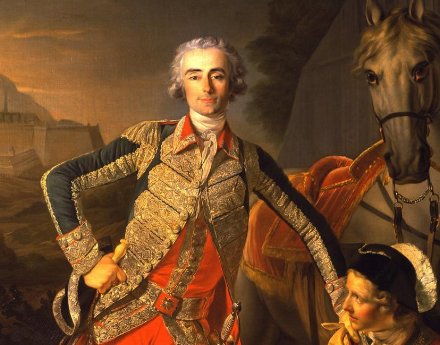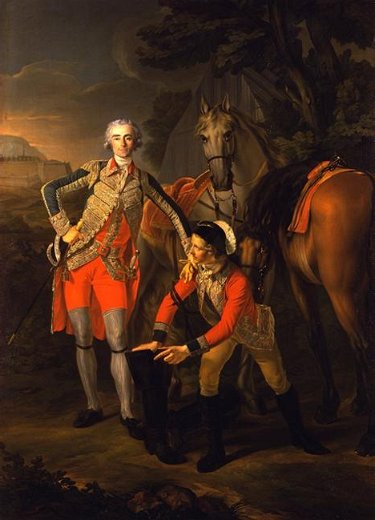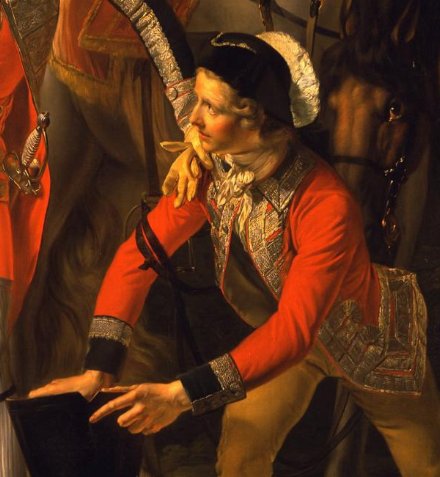
About Andrew Cusack
 Writer, web designer, etc.; born in New York; educated in Argentina, Scotland, and South Africa; now based in London.
Writer, web designer, etc.; born in New York; educated in Argentina, Scotland, and South Africa; now based in London. read more
News
Blogs
Reviews & Periodicals
Arts & Design
World
France
Mitteleuropa
Knickerbockers
Argentina
The Levant
Africa
Cape of Good Hope
Netherlands
Scandinavia
Québec
India
Muscovy
Germany
Academica
Un Écossais en France

CHARLES GRANT, VICOMTE DE VAUX, was a Frenchman of Caledonian extraction who served as a sous-lieutenant in the Scots Company of the Garde du Roi, eventually rising to the rank of Lieutenant Colonel. A cadet branch of the Scottish clan, the Grants in France made sure to maintain links with their kinsmen in the old country. Abbé Peter Grant helped Sir James Grant, 8th Bt., commence an art collection while Sir James was on the Grand Tour in 1759-60. Abbé Grant’s nephew, Baron Grant de Blairfindy, was a fellow Catholic and Colonel in the Légion Royale of Louis XVI.
In a letter to Sir James, who was Chief of the Grants, Blairfindy described their fellow kinsman the Vicomte de Vaux as “a clever, brave officer, polite in company… as brave as his sword,” though, rather disappointingly, the Baron adds that the Vicomte “never drinks”. De Vaux himself took a keen interest in his extended family, and when the terrors of the French Revolution forced him into exile in London, he published there his Mémoires de la Maison Grant depicting the history of the clan.

Painted in 1781-1782 by Louis-Roland Trinquesse, the portrait of Charles Grant, Vicomte de Vaux, (oil on canvas, 113″ x 81¼”) is now available from Colnaghi in Old Bond Street, London, who specialize in old master paintings and drawings. [Click here for a closer look at the painting]. The portait was commissioned as a gift from the Vicomte de Vaux, a Grant in France, to Sir James, as Chief of the Grants. Indeed, Blairfindy had written to Sir James, informing him “you are to have his portrait, which was finished some days agoe. It is a very fine piece, ten feet high, etc. and represents himself, groom and horses as they are in full life and hight. This he intends you should putt up in Castle Grant. It is a very fine piece which, I can assure you, might be putt up in a King’s appartment.”

The groom attentively readies the Vicomte’s boot.
Blairfindy had also written to Sir James that the portait was “done by the King’s first painter and of the same size as those the King sends of himself to the foreign courts”, but failing to mention the portraitist by name. Thus, according to Colnaghi, the portait had previously been attributed to a number of painters to the King of France, namely Jean-Baptiste-Marie Pierre, Jacques Callet, Antoine Vestier, and Joseph-Siffred Duplessis. Dr. Colin Bailey of the Frick, however, has claimed it for Trinquesse, another of the King’s painters (though never elected to the Royal Academy).
Search
Instagram: @andcusack
Click here for my Instagram photos.Most Recent Posts
- Gellner’s Prague December 19, 2024
- Monsieur Bayrou December 18, 2024
- Dempsey Heiner, Art Critic December 17, 2024
- Vote AR December 16, 2024
- Articles of Note: 12 December 2024 December 12, 2024
Most Recent Comments
Book Wishlist
Monthly Archives
Categories



Scotsmen in France? Auch oui!